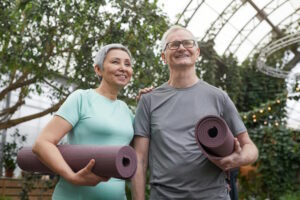
As we age, maintaining physical fitness and flexibility becomes increasingly important for our overall health and well-being. Pilates, a low-impact exercise method, offers numerous benefits for seniors, helping them stay active and mobile. In this guide, we’ll explore the safety and effectiveness of Pilates for seniors, the best Pilates exercises for this demographic, the ways in which Pilates can benefit the elderly, and essential tips for practicing Pilates safely as a senior.
Is Pilates Safe for Seniors?
Pilates is generally considered safe for seniors, but it’s crucial to approach it with some considerations:
1. Consult Your Physician: Before beginning any exercise program, especially if you have preexisting health conditions, consult your healthcare provider. They can assess your physical condition and provide guidance on whether Pilates is a suitable choice for you.
2. Choose the Right Instructor: Ensure that your Pilates instructor has experience working with seniors. They should be knowledgeable about modifications and adjustments to make exercises safe and accessible for older individuals.
3. Adaptations and Modifications: Pilates exercises can be adapted to accommodate various fitness levels and physical limitations. A skilled instructor can modify exercises to suit your needs and ensure safety.
4. Listen to Your Body: Pay close attention to how your body feels during and after Pilates sessions. If an exercise causes pain or discomfort, stop immediately and inform your instructor. It’s essential to communicate any discomfort to prevent injury.
What Are the Best Pilates Exercises for Seniors?
Pilates offers a wide range of exercises that can benefit seniors. Here are some of the best options:
1. Breathing Exercises: Learning to breathe deeply and diaphragmatically can improve lung capacity and oxygenate the body, which is especially important as we age.
2. Pelvic Tilt: This exercise enhances core strength and helps maintain mobility in the lower back.
3. Leg Circles: Leg circle exercises can improve hip joint mobility and strengthen the hip muscles, crucial for balance and mobility.
4. The Hundred: This exercise focuses on deep core engagement and controlled breathing, promoting abdominal strength.
5. Spine Twist: Spine twists can help maintain spinal mobility and improve the range of motion in the upper body.
6. Arm Circles: Arm circles are great for enhancing shoulder mobility and upper body strength, which can be helpful for daily activities.
How Does Pilates Help the Elderly?
Pilates provides several benefits for seniors:
1. Improved Core Strength: Pilates targets the core muscles, which support posture, stability, and balance. Strong core muscles are essential for preventing falls and maintaining independence.
2. Enhanced Flexibility: Many Pilates exercises involve stretching, which can help seniors maintain or improve flexibility, reducing the risk of stiffness and discomfort.
3. Better Posture: Pilates promotes proper alignment and body awareness, helping seniors maintain good posture and reduce the risk of developing musculoskeletal issues.
4. Balance and Coordination: Pilates exercises challenge balance and coordination, which are critical skills for seniors to prevent falls and stay agile.
5. Stress Reduction: Pilates incorporates relaxation techniques and controlled breathing, which can help reduce stress and promote mental well-being.
How to Do Pilates Safely?
To practice Pilates safely as a senior, follow these guidelines:
1. Consult Your Physician: Always check with your healthcare provider before starting a new exercise program, especially if you have underlying health conditions.
2. Choose the Right Instructor: Select a Pilates instructor with experience working with seniors and the ability to modify exercises as needed.
3. Start Slowly: Begin with beginner-level exercises and gradually progress as you build strength and confidence.
4. Listen to Your Body: Pay attention to how your body feels during exercises. If you experience pain or discomfort, stop and inform your instructor.
5. Stay Hydrated: Drink plenty of water before, during, and after your Pilates sessions to stay hydrated.
6. Use Proper Equipment: If using specialized Pilates equipment, ensure it is in good condition and adjusted to your body size and needs.
Summarizing the Answers
In summary, Pilates can be a safe and effective exercise method for seniors, offering numerous benefits such as improved core strength, flexibility, posture, balance, and stress reduction. To practice Pilates safely, consult your physician, choose a qualified instructor, start slowly, listen to your body, and use proper equipment. With the right guidance and mindful practice, Pilates can help seniors stay active, mobile, and enjoy a better quality of life as they age.